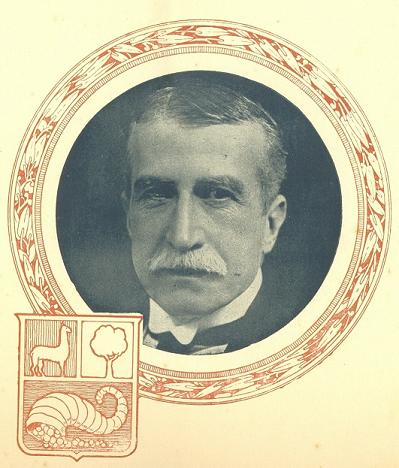- Augusto B. Leguía
Infobox Officeholder
name = Augusto B. Leguía |225px
|225px
order = 32ndPresident of Peru
order2 = 35thPresident of Peru
term_start =September 24 1908
term_end =September 24 1912
term_start2 =July 4 1919
term_end2 =August 25 1930
predecessor = José Pardo
predecessor2 = José Pardo
successor =Guillermo Billinghurst
successor2 = Manuel Ponce
birth_date = birth date|1863|2|19|mf=y
death_date = death date and age|1932|2|7|1863|2|19|mf=y
party = Civil Party, Democratic Reformist Party
profession =Economist Augusto Bernardino Leguía y Salcedo (1863 – 1932) was a Peruvian politician who twice occupied the Presidency of
Peru , from 1908 to 1912 and from 1919 to 1930.Early life
Augusto Leguía was born in
Lambayeque in 1863 to one of the most distinguished families of the Peruvian oligarchy. Educated inValparaíso ,Chile , he served in the Peruvian army during theWar of the Pacific (1879-1881).After the war he moved to the United States and became an insurance executive with the
New York Life Insurance Company . By the 1900s, Leguía had become very wealthy and decided to return to Peru. He entered politics in 1903 at the urging ofManuel Candamo (the then leader of theCivilista Party ) and also of José Pardo, who wasPrime Minister . Leguía took the position ofMinister of Finance , a post he would retain until 1904, when the former Prime Minister José Pardo became president. Pardo offered the position of Prime Minister to Leguía, who accepted and remained so until 1907, when he resigned to run for the presidency the following year.First presidential term
In 1908 he succeeded José Pardo (a succession event that would occur again in 1919) after being elected president for the first time by an alliance of the Civil and Constitutional parties. Some of Leguía's first actions were to institute social and economic reforms in an attempt to industrialize Peru and turn it into a modern capitalist society.
On
May 29 ,1909 , a group of citizens (supporters of Piérola's Democratic Party) managed to force their entry into the "Palacio de Gobierno" demanding the resignation of Leguía. Among the group were the brother and sons of Piérola; "Carlos de Piérola", "Isaías de Piérola" and "Amadeo de Piérola". Since Leguía did not resign as planned, they kidnapped him and took him in front of the Bolivar Monument (located in "Plaza inquisicion" in Lima). Once there, Leguía did not acquiesce to their demands, and the police had to forcibly rescue the president in the midst of a fight that caused at least 100 deaths.During this period the country was also confronting boundary disputes with five of its neighbors. Leguía succeeded in reaching agreements with two of them,
Bolivia andBrazil .
*The Boundary withBrazil was settled with the signing of the "Treaty of Velarde-Río Branco". This provided that two rivers (Yaravi andYaverija ) would compose most of the border for both countries.
*WithBolivia , The "Treaty of Polo-Bustamante" determined the partition of theLake Titicaca and provided a much accurate definition of the Peruvian-Bolivian border. This treaty also delimited the borders with Tacna (which was until then in Chilean control).When Leguía's term ended in 1912, he was succeeded by
Guillermo Billinghurst , a millionaire businessman who had been the former mayor ofLima . During the following years, Leguía travelled in theUnited Kingdom and theUnited States , where he learned methods of banking and finance that he would later apply in Peru. During this time, Leguia was already in conflict with the "Civilista Party " and left its organization.Second presidential term
In 1919, he again sought the presidency of Peru by trying to succeed José Pardo. Fearing that the former president's government along with the Civilist Parliament would not recognise his victory, he launched a successful military coup, which led Leguía to succeed Pardo as an interim president. He then proceeded to dissolve Congress and the new parliament elected him constitutional president of Peru.
Leguía changed the Peruvian constitution (which had the longest continuance since 1860), and promulgated a new one in 1920, which was more liberal than its predecessor and provided more civil guarantees and unlimited reelections. Nevertheless, having himself promulgated the constitution, Augusto B. Leguía almost completely ignored it and the next 10 years of his tenure were marked with a dictatorial style of ruling by suppressing all opposition harshly. Various political opponents of his government were exiled, of which the most prominent was
Víctor Raúl Haya de la Torre , who while in exile inMexico founded theAmerican Popular Revolutionary Alliance (APRA) in 1924. It became one of modern Peru's most active and also most trouble-maker political parties. Another important political figure that would emerge during this era wasJosé Carlos Mariátegui , leader of theCommunist Party of Peru .Among the positive initiatives that occurred during Leguía's second term was a program to modernize Lima by planning and starting public works through various loans. These included improving the health-care system by founding hospitals and building drainage systems around the cities. Peru's Government Palace ("Palacio de Gobierno") was also remodeled in 1926. Banks such as the
Banco Central de Reserva del Perú andBanco Hipotecario of Peru were also created during his second presidency.Treaties of limits with
Colombia andChile were also signed:
*The boundary with Colombia was settled with the secession of all the lands between thePutumayo andCaquetá rivers. This was officially solved with the signing of the "Treaty of Salomón-Lozano" in 1922. (However, the treaty was published after the overthrow of Leguía in 1930.)
*TheTacna-Arica compromise was also signed with Chile, which unfortunately led to economic depression in later years. Leguía was bitterly criticized for accepting the compromise.Overthrow
The
world depression had drained foreign investment in Peru and after eleven years in power, Leguía's government was overthrown. The coup, on August 22, 1930, was led byLuis Miguel Sánchez Cerro inArequipa . Leguía was arrested and charged with misappropriating government funds. He remained in confinement in thePanóptico of Lima , and died at a naval hospital onFebruary 6 ,1932 .
Wikimedia Foundation. 2010.
